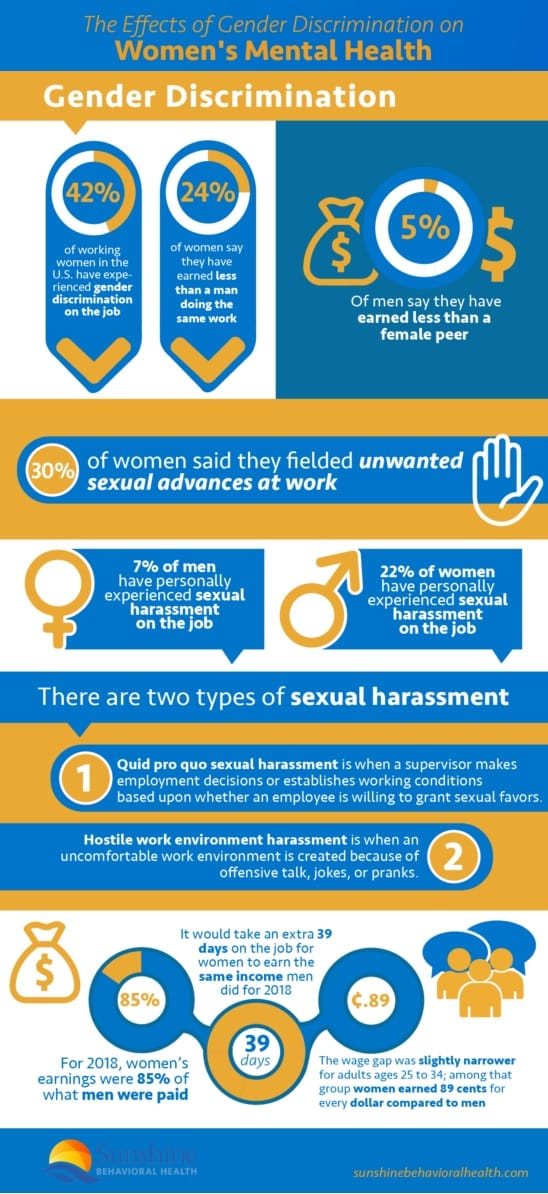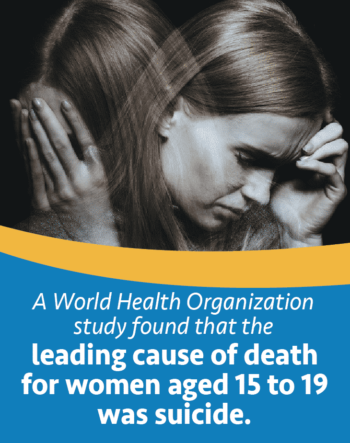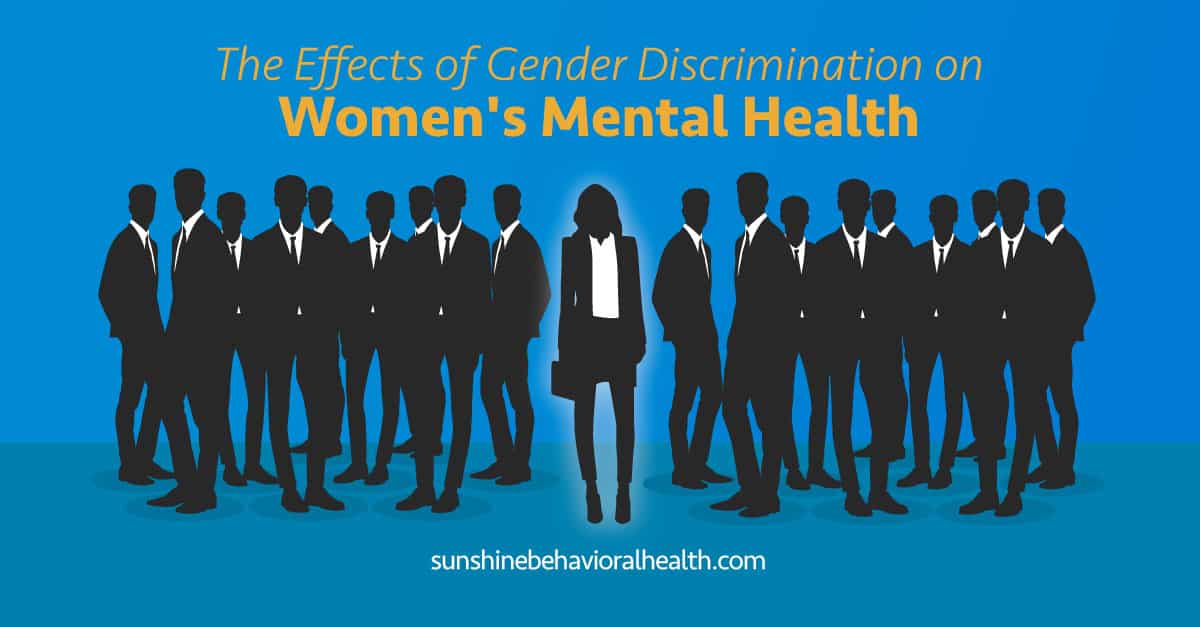Gender discrimination takes on many forms, affecting primarily women, but also men. It occurs in the workplace, in the classroom, in sports, and even in the home. Unchecked, it can take a toll on mental health. Read on to learn more.
Gender discrimination comes in many forms and can affect people at any stage of life. It affects women more, however, and those biases—which can occur in ways both subtle and overt—not only impact women but trickle through society as well.
Only a handful of nations give women equal rights in the workplace. That impacts not only what responsibilities a woman may get on the job, but also what her paycheck may be.
Sexual assault and harassment continue to be on the radar. (The #MeToo movement still has a pulse, after all, and terms like “mansplaining”—where a man explains something to a woman in a tone that’s seen as condescending—have entered the lexicon.)
Discrimination against gender affects not only life in the schoolyard or the workplace, but it also impacts the pocketbook and can have a lasting negative effect on mental health.
What is Gender Discrimination?
Gender discrimination is the unequal or disadvantageous treatment of an individual or group based on gender or gender identity. It arises from differences in gender roles that have been socially constructed and can occur in various settings, including academia, the workplace, or at home.

Direct Discrimination
Direct discrimination occurs when someone is treated worse than another person or other people because they have a legally protected characteristic or are connected with someone with that characteristic. The circumstances of both people must be similar enough that a valid comparison between treatments can be made. For example, direct discrimination might occur when a woman and man are both performing the same job, but the man is paid more money or receives better benefits.
Direct discrimination is when you are treated worse than someone else because:
- You have a legally protected characteristic such as race, age, or gender
- Someone thinks you have that characteristic (known as discrimination by perception)
- You are associated with someone with that characteristic
Your circumstances must be similar enough to the person’s circumstances being treated better for a valid comparison to be made.
Direct discrimination still applies if you can show that the person who lacked the protected characteristic would have been treated better in similar circumstances, even if you cannot point specifically to another person who has been treated better.
A person can still be a member of a protected group themselves and discriminate against others in their group; for example, a woman could be guilty of discriminating against another woman if she treats men who work for her better than she treats women of equal rank.
Indirect Discrimination
Indirect discrimination happens when a policy, practice, rule, or arrangement that applies in the same way for everybody disadvantages a legally protected group of people who share a characteristic that is legally protected such as race or gender.
The rule or practice is considered discrimination whether or not that was the intention unless the policy’s creator can show a legitimate reason for the differences in the policy’s application.
Harassment
Harassing an individual because of gender is illegal.
Harassment can be sexual, as in requests for sexual favors, unwelcome sexual advances, and other physical or verbal harassment of a sexual nature. It also can be harassment based on gender, such as unwelcome and negative comments about a person’s gender or women in general. Women can be harassed by men or by other women.
The law doesn’t prohibit one-off comments or teasing but rather frequent or severe incidents that create an offensive or uncomfortable environment. The law also prohibits firing or demoting women who refuse to submit to sexual advances or who complain of sexual harassment.
Sexual harassment has two types.
- Quid pro quo sexual harassment occurs when a boss makes employment decisions or establishes working conditions based upon whether an employee is willing to grant sexual favors.
- Hostile work environment harassment occurs when an uncomfortable work environment is created because of offensive talk, jokes, or pranks.
Victimization
Gender victimization occurs when someone is a victim of a crime or act that is gender-based. Forms of victimization include sexual assault, genital mutilation, sex trafficking, incest, and domestic violence. Both men and women can victimize women; for example, either a woman or man could run a sex trafficking scheme or beat up a female spouse.
Gender Discrimination in Education
The federal law, Title IX of the Education Amendments of 1972, makes discrimination based on gender illegal in education. It allows women students equal access to educational and extracurricular activities in schools and colleges. It also makes it illegal to punish someone for reporting or demonstrating against gender discrimination and prohibits sexual harassment in education.
While the law applies to staff and faculty, as well as students, employees receive gender discrimination protections from employment laws. Certain states may have similar laws.
Despite these laws, however, gender discrimination does occur in education. For example, teachers with traditional gender roles may inadvertently pass along stereotypes. These stereotypes can harm female students’ performance.
One study found that female students who had a teacher with these traditional roles performed worse than those who didn’t. Other studies have found that teachers of small children sometimes encourage gender stereotypes by having boys play with tractors and girls play with dolls.
Champion Women’s survey found that 90% of universities discriminate against women in sports, despite Title IX. They also are denied millions of dollars in athletic scholarships. The National Collegiate Athletic Association (NCAA) colleges would have to provide women an additional 148,030 sports opportunities to equal the ratio of those offered to men.
Gender Discrimination in Employment
Title VII of the Federal Civil Rights Act makes discrimination against someone based on gender illegal. The law applies to those companies with 15 or more people and applies to pay, hiring, firing, promotion opportunities, and perks. States sometimes also have laws against gender discrimination.
Despite laws against gender discrimination in employment, women are still discriminated against in terms of pay and promotion opportunities and face sexual harassment. Sometimes discrimination is overt, but often it is more subtle.
For example, a woman who is a strong leader might be criticized in her performance review for being aggressive, and that appraisal might cost her a raise or promotion.
Another example is a woman who doesn’t present herself to fit with feminine stereotypes being held to a different standard.
Equal Pay Discrimination
The Equal Pay Act of 1963 requires that women receive the same pay as men for performing the same job or substantially equal jobs. Despite this, however, in 2018, women were paid 81.6 cents for every dollar a man earns. The gap is even wider for women of color.
The gap is narrowing a bit for younger women who receive about 89 cents on a man’s dollar. The pay gap also varies by state. The gap is smallest in California and largest in Louisiana.
Pregnancy Discrimination
Despite the Pregnancy Discrimination Act prohibiting bias against pregnant women or any medical condition related to pregnancy in any aspect of the job, women sometimes still face discrimination, such as:
- Failure to receive leave under the same conditions as a man would receive it for a disability.
- Failure to hire a pregnant woman because they fear she will take time off immediately.
- Failure to provide a secure, private place for pumping breast milk.
Women continue to face discrimination because of being pregnant or giving birth; about 31,000 pregnancy discrimination charges were filed with the Equal Employment Opportunity Commission between 2010 and 2015.
Gender Discrimination at Home
Women who work sometimes face the double barrier of discrimination at work and home.
Women still often do more than their fair share of child care and home chores. One study found that women who work outside the home spend an extra 18 hours a week doing household or childcare related chores, while men average 12 minutes a day.
Another study showed that while modern couples don’t purposefully divide household chores along gender lines, they rationalize by saying that women are more competent at household chores and more motivated to do them.
Couples who can equalize chores might receive big dividends. Those women who have equal partners at home could be more successful at their work. Fathers who tackle an equal number of chores also set good gender role models for their children.
The Effects of Gender Discrimination on Mental Health
 Discrimination can negatively affect women’s mental health, both short- and long-term.
Discrimination can negatively affect women’s mental health, both short- and long-term.
The effects of discrimination—less schooling, lower pay, reduced leadership opportunities, shouldering more of the caregiving burden, and experiencing higher rates of domestic violence—can take a toll.
Smaller slights in the form of perceived discrimination also affect well-being and chances to get ahead (or simply achieve equality). Less pay also means less access to better health care, which does not bode well for both physical or mental wellness.
One study followed a group of women for more than a decade. More than 10% said they’d experienced “perceived gender discrimination” while pregnant. That group also experienced higher rates of depression. Stress can also lead to drug abuse for or other anxiety drugs.
Another study found pay disparities were linked to mental disorders like anxiety and depression, and they reduced self-esteem.
Women also can become frustrated and feel powerless when discriminated against and turn that anger inward, becoming depressed and anxious. They also sometimes blame themselves for the problems even if the institution is at fault.
Cultural norms and expectations can also lead to stigma, violence, and exclusion, making women more vulnerable to attack and a silenced voice in society, further straining mental health.
A recent Columbia University study found that when women earned a lower income compared with their male counterparts, they were:
- 2.4 times more likely to suffer depression.
- Four times more likely to suffer anxiety.
A study at the University of Pittsburgh School of Medicine also found links between sexual harassment and higher incidences of mental health issues, particularly depression, anxiety, and sleep disruptions.
Women who experience sexual violence such as rape suffer short and long-term psychological effects. Many survivors report flashbacks of their assault and feelings of guilt, shame, isolation, and confusion.
Over the longer term, these survivors can develop depression, generalized anxiety, and post-traumatic stress disorder (PTSD). PTSD is an anxiety disorder that can develop after experiencing a traumatic event and can continue for weeks, months, or longer.
Victims of sexual violence also are more likely to abuse alcohol or other drugs or develop eating disorders such as anorexia nervosa, bulimia nervosa, and binge eating disorder.
Gender discrimination also can kill. A World Health Organization study found that suicide was the leading cause of death for women aged 15 to 19. Those suicides were most often a result of depression and anxiety related to having experienced gender bias or gender-related violence.
The Effects of Gender Discrimination on Addiction
Women sometimes even experience bias in terms of how addiction is perceived. Women face different struggles. A male with a substance use disorder may have the support of a wife, girlfriend, or female relative who helps care for the family while he uses or is in recovery.
Women face different struggles; they tend to have less support and more responsibility to shoulder. That complicates their recovery.
Women with substance use disorders also face more disapproval. Their addiction may be perceived as more of a moral failing rather than a chronic illness. That can affect their decision to seek help as well as their mental health due to stigma and delaying treatment.
How to Deal With Gender Discrimination
Often victims of gender discrimination or discrimination based on gender identity feel the situation is their fault and keep silent. However, an effective way to deal with it is to tell someone—either the boss of the perpetrator, human resources, or a member of the staff. Write to advertisers if they depict women in stereotypical or unfair ways. Join local advocacy groups.
If an incident occurs, write everything down as soon as you are able while things are fresh in your mind. Keep any relevant emails. Report the incident to human resources or another authority in writing or, if you report it verbally, immediately write down the conversation, the date and time, where it took place, and if there were witnesses present.
If you think you might want to file a lawsuit in federal or state court eventually, you must first file a claim with the EEOC or similar authority by the deadline.
Finally, practice self-care. You can do this in several ways including:
- Use positive affirmations to calm the inner critic. For example, if you find yourself ruminating over something negative an offender said to you, try to interrupt that thought and replace it with a positive one.
- Find a sport or workout such as kickboxing, running, or dance cardio to work through the rage, grief, and hurt.
- Eat balanced meals.
- Practice mindful breathing and meditation to rewire the brain or engage in something creative such as art or music. The brain tends to split a traumatic event to make it easier to digest, and art can reintegrate it and enable the brain to process and master the event.
- Practice compassion and patience with yourself as you heal.
Getting Help
Asking for help is a sign of strength, not weakness. The first step in getting treatment for most mental health and substance use disorder issues is your primary care physician. Your doctor can do an initial screening and refer you to specialists or programs that can help.
If you have a faith community, you might also seek help through your clergy person or gain a referral to a faith-based counselor. You can also find names by searching online databases.
Typically, the first line of treatment for depression or anxiety is talk therapy. You discuss your feelings with a trained therapist who can help you manage triggers that might exacerbate your condition. Medication is another line of treatment.
Some who have PTSD may recover without professional psychiatric help if they have a good support system. However, most will need treatment from a therapist or psychiatrist.
When women get treatment for a substance use disorder disorder, they may need to go through a medically supervised detox program as an outpatient or in a treatment center.
Behavioral therapies, counseling, and 12-step plans may also be part of their recovery plan. If a diagnosis such as depression or anxiety underlies their substance use disorder disorder, experts recommend they also get treatment for that co-occurring disorder at the same time.
Where to Find Help
- ACLU (American Civil Liberties Union) – Has information on rights and on types of sex discrimination as well as attorney locators and resources for free to low-cost legal help.
- Equal Rights Advocates – Helps the public better know their rights and options when facing gender discrimination. Also has forms people can fill out to consult with one of their legal counselors.
- National Conference of State Legislatures (NCSL) – Has information on states’ and territories’ sex, gender identity, and sexual orientation discrimination laws.
- National Domestic Violence Hotline – Provides support and advice for survivors of domestic violence.
- U.S. Equal Employment Opportunity Commission (EEOC) – Anyone who believes they have been discriminated against on basis or sex (including gender identity, pregnancy, or sexual orientaiton), race, color, religion, national origin, or disability can file a claim. Many states have Fair Employment Practices Agencies, often governed by laws similar to the EEOC’s.
Sources
Medical disclaimer:
Sunshine Behavioral Health strives to help people who are facing substance abuse, addiction, mental health disorders, or a combination of these conditions. It does this by providing compassionate care and evidence-based content that addresses health, treatment, and recovery.
Licensed medical professionals review material we publish on our site. The material is not a substitute for qualified medical diagnoses, treatment, or advice. It should not be used to replace the suggestions of your personal physician or other health care professionals.







